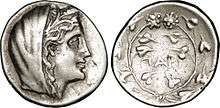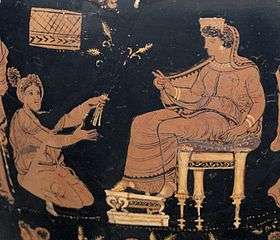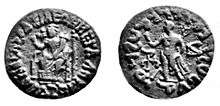Demeter
In ancient Greek religion and mythology, Demeter (/dɪˈmiːtər/; Attic: Δημήτηρ Dēmḗtēr [dɛːmɛ́ːtɛːr]; Doric: Δαμάτηρ Dāmā́tēr) is the goddess of the harvest and agriculture, presiding over grains and the fertility of the earth. Her cult titles include Sito (Σιτώ), "she of the Grain",[2] as the giver of food or grain,[3] and Thesmophoros (θεσμός, thesmos: divine order, unwritten law; φόρος, phoros: bringer, bearer), "Law-Bringer", as a mark of the civilized existence of agricultural society.[4]
| Demeter | |
|---|---|
Goddess of the harvest, agriculture, fertility and sacred law. | |
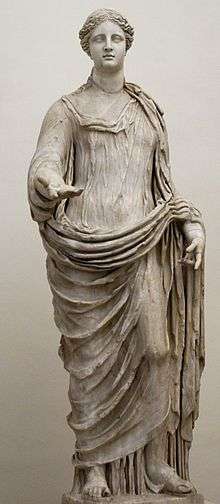 A marble statue of Demeter, National Roman Museum | |
| Other names | Sito, Thesmophoros |
| Abode | Mount Olympus |
| Symbol | Cornucopia, wheat, torch, bread |
| Festivals | Thesmophoria, Eleusinian Mysteries |
| Personal information | |
| Parents | Cronus and Rhea |
| Siblings | Hestia, Hera, Hades, Poseidon, Zeus, Chiron |
| Consort | Iasion, Zeus, Poseidon |
| Children | Persephone, Dionysus, Despoina, Arion, Plutus, Philomelus |
| Equivalents | |
| Roman equivalent | Ceres |
| Hinduism equivalent | Bhūmi |
| Japanese equivalent | Amaterasu[1] |
Though Demeter is often described simply as the goddess of the harvest, she presided also over the sacred law, and the cycle of life and death. She and her daughter Persephone were the central figures of the Eleusinian Mysteries, a religious tradition that predated the Olympian pantheon, and which may have its roots in the Mycenaean period c. 1400–1200 BC.[5] Demeter was often considered to be the same figure as the Anatolian goddess Cybele, and she was identified with the Roman goddess Ceres.
Etymology
It is possible that Demeter appears in Linear A as da-ma-te on three documents (AR Zf 1 and 2, and KY Za 2), all three apparently dedicated in religious situations and all three bearing just the name (i-da-ma-te on AR Zf 1 and 2).[6] It is unlikely that Demeter appears as da-ma-te in a Linear B (Mycenean Greek) inscription (PY En 609); the word 𐀅𐀔𐀳, da-ma-te, probably refers to "households".[7][8] On the other hand, 𐀯𐀵𐀡𐀴𐀛𐀊, si-to-po-ti-ni-ja, "Potnia of the Grain", is regarded as referring to her Bronze Age predecessor or to one of her epithets.[9]
Demeter's character as mother-goddess is identified in the second element of her name meter (μήτηρ) derived from Proto-Indo-European (PIE) *méh₂tēr (mother).[10] In antiquity, different explanations were already proffered for the first element of her name. It is possible that Da (Δᾶ),[11] a word which corresponds to Gē (Γῆ) in Attic, is the Doric form of De (Δῆ), "earth", the old name of the chthonic earth-goddess, and that Demeter is "Mother-Earth".[12] Liddell & Scott find this "improbable" and Beekes writes, "there is no indication that [da] means "earth", although it has also been assumed in the name of Poseidon" found in the Linear B inscription E-ne-si-da-o-ne, "earth-shaker".[13][14][15] John Chadwick also argues that the dā element in the name of Demeter is not so simply equated with "earth".[16]
M. L. West has proposed that Demeter, initially Damater, could be a borrowing from an Illyrian deity attested in the Messapic goddess Damatura, with a form dā- ("earth", from PIE *dʰǵʰ(e)m-)[lower-alpha 1] attached to -matura ("mother"), akin to the Illyrian god Dei-paturos (dei-, "sky", attached to -paturos, "father"). The Lesbian form Dō- may simply reflect a different dialectal pronunciation of the non-Greek name.[18] The element De- may also be connected with Deo, an epithet of Demeter[19] could derive from the Cretan word dea (δηά), Ionic zeia (ζειά)—variously identified with emmer, spelt, rye, or other grains by modern scholars—so that she is the Mother and the giver of food generally.[20][21] This view is shared by British scholar Jane Ellen Harrison, who suggests that Démeter's name means Grain-Mother, instead of Earth-Mother.[22]
Wanax (wa-na-ka) was her male companion (Greek: Πάρεδρος, Paredros) in Mycenaean cult.[23] The Arcadian cult links her to the god Poseidon, who probably substituted the male companion of the Great Goddess ; Demeter may therefore be related to a Minoan Great Goddess (Cybele).[24]
An alternative Proto-Indo-European etymology comes through Potnia and Despoina, where Des- represents a derivative of PIE *dem (house, dome), and Demeter is "mother of the house" (from PIE *dems-méh₂tēr).[25] R. S. P. Beekes rejects a Greek interpretation, but not necessarily an Indo-European one.[14]
Iconography
Demeter was frequently associated with images of the harvest, including flowers, fruit, and grain. She was also sometimes pictured with her daughter Persephone. Demeter is not generally portrayed with any of her consorts; the exception is Iasion, the youth of Crete who lay with her in a thrice-ploughed field, and was sacrificed afterwards by a jealous Zeus with a thunderbolt.
Demeter is assigned the zodiac constellation Virgo the Virgin by Marcus Manilius in his 1st century Roman work Astronomicon. In art, constellation Virgo holds Spica, a sheaf of wheat in her hand and sits beside constellation Leo the Lion.
In Arcadia, she was known as "Black Demeter". She was said to have taken the form of a mare to escape the pursuit of her younger brother, Poseidon, and having been raped by him despite her disguise, dressed all in black and retreated into a cave to mourn and to purify herself. She was consequently depicted with the head of a horse in this region.[26] A sculpture of the Black Demeter was made by Onatas.
Description
As goddess of agriculture
In epic poetry and Hesiod's Theogony, Demeter is the Corn-Mother, the goddess of cereals who provides grain for bread and blesses its harvesters. This was her main function at Eleusis, and became panhellenic. In Cyprus, "grain-harvesting" was damatrizein. The main theme in the Eleusinian mysteries was the reunion of Persephone with her mother Demeter, when new crops were reunited with the old seed, a form of eternity.
According to the Athenian rhetorician Isocrates, Demeter's greatest gifts to humankind were agriculture, particularly of cereals, and the Mysteries which give the initiate higher hopes in this life and the afterlife.[27] These two gifts were intimately connected in Demeter's myths and mystery cults. In Hesiod, prayers to Zeus-Chthonios (chthonic Zeus) and Demeter help the crops grow full and strong.[28] Demeter's emblem is the poppy, a bright red flower that grows among the barley.[29]
Demeter was also zeidoros arοura, the Homeric "Mother Earth arοura" who gave the gift of cereals (zeai or deai).[30]
As an earth and underworld goddess
In addition to her role as an agricultural goddess, Demeter was often worshipped more generally as a goddess of the earth. In Arcadia, she was represented as snake-haired, holding a dove and dolphin, perhaps to symbolize her power over the underworld, the air, and the water. In the cult of Flya, she was worshiped as Anesidora, one who sends up gifts from the underworld. There was a temple of Demeter under this name in Phlius in Attica.[31][32][33] In Sparta, she was known as Demeter-Chthonia (chthonic Demeter).[34] The Athenians called the dead "Demetrioi",[35] and this may reflect a link between Demeter and ancient cult of the dead, linked to the agrarian-belief that a new life would sprout from the dead body, as a new plant arises from buried seed. This was probably a belief shared by initiates in Demeter's mysteries, as interpreted by Pindar: "Happy is he who has seen what exists under the earth, because he knows not only the end of life, but also his beginning that the Gods will give".
In the mysteries of Pheneos in Arcadia, Demeter was known as Kidaria.[36] Her priest would put on the mask of Demeter, which was kept in a secret place. The cult may have been connected with both the underworld and a form of agrarian magic.[37]
As a poppy goddess
Theocritus described one of Demeter's earlier roles as that of a goddess of poppies:
- For the Greeks Demeter was still a poppy goddess
- Bearing sheaves and poppies in both hands. — Idyll vii.157
Karl Kerenyi asserted that poppies were connected with a Cretan cult which was eventually carried to the Eleusinian mysteries in Classical Greece. In a clay statuette from Gazi (Heraklion Museum, Kereny 1976 fig 15), the Minoan poppy goddess wears the seed capsules, sources of nourishment and narcosis, in her diadem. According to Kernyi, "It seems probable that the Great Mother Goddess who bore the names Rhea and Demeter, brought the poppy with her from her Cretan cult to Eleusis and it is almost certain that in the Cretan cult sphere opium was prepared from poppies."[38] Robert Graves speculated that the meaning of the depiction and use of poppies in the Greco-Roman myths is the symbolism of the bright scarlet color as signifying the promise of resurrection after death.[39]
Other functions and titles
Demeter's epithets show her many religious functions. She was the "Corn-Mother" who blesses the harvesters. Some cults interpreted her as "Mother-Earth". Demeter may be linked to goddess-cults of Minoan Crete, and embody aspects of a pre-Hellenic Mother Goddess.[40] It is possible that the title "Mistress of the labyrinth", which appears in a Linear B inscription, belonged originally to Sito ("[she] of the grain"), the Great Mother Demeter and that in the Eleusinian mysteries this title was kept by her daughter Persephone (Kore or Despoina).[41] However, there is no evidence that the name of Potnia in Eleusis was originally Demeter. Her other epithets include:
- Aganippe ("the Mare who destroys mercifully", "Night-Mare")
- Potnia ("mistress") in the Homeric Hymn to Demeter. Hera especially, but also Artemis and Athena, are addressed as "potnia" as well.
- Despoina ("mistress of the house"), a Greek word similar to the Mycenean potnia. This title was also applied to Persephone, Aphrodite and Hecate.
- Thesmophoros ("giver of customs" or even "legislator"), a role that links her to the even more ancient goddess Themis,[4] derived from thesmos, the unwritten law.[42] This title was connected with the Thesmophoria, a festival of secret women-only rituals in Athens connected with marriage customs.
- Erinys ("implacable"),[43] with a function similar with the function of the avenging Dike (Justice), goddess of moral justice based on custom rules who represents the divine retribution,[44] and the Erinyes, female ancient chthonic deities of vengeance and implacable agents of retribution.
- Chloe ("the green shoot"),[45] that invokes her powers of ever-returning fertility, as does Chthonia.
- Europa ("broad face or eyes") at Livadeia of Boeotia. She was the nurse of Trophonios to whom a chthonic cult and oracle was dedicated.[46]
Demeter might also be invoked in the guises of:
Worship
In Crete
The earliest recorded worship of a deity possibly equivalent to Demeter is found in Linear B Mycenean Greek tablets of c. 1400–1200 BC found at Pylos. The tablets describe worship of the "two queens and the king",[49] which may be related to Demeter, Persephone and Poseidon.[5] An early name which may refer to Demeter, si-to-po-ti-ni-ja (Sito Potnia), appears in Linear B inscriptions found at Mycenae and Pylos.[50] In Crete, Poseidon was often given the title wa-na-ka (wanax) in Linear B inscriptions, in his role as king of the underworld, and his title E-ne-si-da-o-ne indicates his chthonic nature. In the cave of Amnisos, Enesidaon is associated with the cult of Eileithyia, the goddess of childbirth,[51] who was involved with the annual birth of the divine child.[52] During the Bronze Age, a goddess of nature dominated both in Minoan and Mycenean cults, and Wanax (wa-na-ka) was her male companion (paredros) in the Mycenean cult.[51] Elements of this early form of worship survived in the Eleusinian cult, where the following words were uttered: "Mighty Potnia bore a strong son."[53]
On the Greek mainland
Tablets from Pylos record sacrificial goods destined for "the Two Queens and Poseidon" ("to the Two Queens and the King" :wa-na-ssoi, wa-na-ka-te). The "Two Queens" may be related with Demeter and Persephone, or their precursors, goddesses who were no longer associated with Poseidon in later periods.[49]
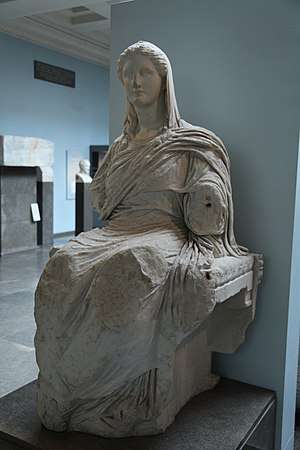
Major cults to Demeter are known at Eleusis in Attica, Hermion (in Crete), Megara, Celeae, Lerna, Aegila, Munychia, Corinth, Delos, Priene, Akragas, Iasos, Pergamon, Selinus, Tegea, Thoricus, Dion (in Macedonia)[54] Lykosoura, Mesembria, Enna (Sicily), and Samothrace.
An ancient Amphictyony, probably the earliest centred on the cult of Demeter at Anthele (Ἀνθήλη), which lay on the coast of Malis south of Thessaly. This was the locality of Thermopylae.[55][56]
After the "First Sacred War", the Anthelan body was known thenceforth as the Delphic Amphictyony[55]
Demeter of Mysia had a seven-day festival at Pellené in Arcadia.[57] Pausanias passed the shrine to Demeter at Mysia on the road from Mycenae to Argos but all he could draw out to explain the archaic name was a myth of an eponymous Mysius who venerated Demeter.
Festivals
Demeter's two major festivals were sacred mysteries. Her Thesmophoria festival (11–13 October) was women-only.[58] Her Eleusinian mysteries were open to initiates of any gender or social class. At the heart of both festivals were myths concerning Demeter as Mother and Persephone as her daughter.
Conflation with other goddesses
In the Roman period, Demeter became conflated with the Roman agricultural goddess Ceres under the Interpretatio graeca.[59] The worship of Demeter was formally merged with that of Ceres around 205 BC, along with the ritus graecia cereris, a Greek-inspired form of cult, as part of Rome's general religious recruitment of deities as allies against Carthage, towards the end of the Second Punic War. The cult originated in southern Italy (part of Magna Graecia) and was probably based on the Thesmophoria, a mystery cult dedicated to Demeter and Persephone as "Mother and Maiden". It arrived along with its Greek priestesses, who were granted Roman citizenship so that they could pray to the gods "with a foreign and external knowledge, but with a domestic and civil intention".[60] The new cult was installed in the already ancient Temple of Ceres, Liber and Libera, Rome's Aventine patrons of the plebs; from the end of the 3rd century BC, Demeter's temple at Enna, in Sicily, was acknowledged as Ceres' oldest, most authoritative cult center, and Libera was recognized as Proserpina, Roman equivalent to Persephone.[61] Their joint cult recalls Demeter's search for Persephone, after the latter's abduction into the underworld by Hades (or Pluto). At the Aventine, the new cult took its place alongside the old. It made no reference to Liber, whose open and gender-mixed cult continued to play a central role in plebeian culture, as a patron and protector of plebeian rights, freedoms and values. The exclusively female initiates and priestesses of the new "greek style" mysteries of Ceres and Proserpina were expected to uphold Rome's traditional, patrician-dominated social hierarchy and traditional morality. Unmarried girls should emulate the chastity of Proserpina, the maiden; married women should seek to emulate Ceres, the devoted and fruitful Mother. Their rites were intended to secure a good harvest, and increase the fertility of those who partook in the mysteries.[62]
Beginning in the 5th century BCE in Asia Minor, Demeter was also considered equivalent to the Phrygian goddess Cybele.[63] Demeter's festival of Thesmophoria was popular throughout Asia Minor, and the myth of Persephone and Adonis in many ways mirrors the myth of Cybele and Attis.[64]
Some late antique sources syncretized several "great goddess" figures into a single deity. The Platonist philosopher Apuleius, writing in the late 2nd century, identified Ceres (Demeter) with Isis, having her declare:
"I, mother of the universe, mistress of all the elements, first-born of the ages, highest of the gods, queen of the shades, first of those who dwell in heaven, representing in one shape all gods and goddesses. My will controls the shining heights of heaven, the health-giving sea-winds, and the mournful silences of hell; the entire world worships my single godhead in a thousand shapes, with divers rites, and under many a different name. The Phrygians, first-born of mankind, call me the Pessinuntian Mother of the gods; ... the ancient Eleusinians Actaean Ceres; ... and the Egyptians who excel in ancient learning, honour me with the worship which is truly mine and call me by my true name: Queen Isis."
- --Apuleius, translated by E. J. Kenny. The Golden Ass[65]
Mythology
Family and consorts
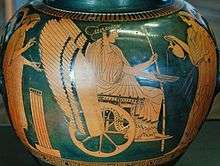
Some of the earliest accounts of Demeter's relationships to other deities comes from Hesiod's Theogeny, written c. 700 BC. In it, Demeter is described as the daughter of Cronus and Rhea.
Demeter's most well-known relationship is with her daughter, Persephone, queen of the underworld. Both Homer and Hesiod described Persephone as the daughter of Zeus and his older sister, Demeter,[66] though no myths exist describing her conception or birth. The exception is a fragment of the lost Orphic theogony, which preserves part of a myth in which Zeus mates with his mother, Rhea, in the form of a snake, explaining the origin of the symbol on Hermes' staff. Their daughter is said to be Persephone, whom Zeus in turn mates with to conceive Dionysus. According to the Orphic fragments, "After becoming the mother of Zeus, she who was formerly Rhea became Demeter."[67][68]
Before her abduction by Hades, Persephone was known as Kore ("maiden"), and there is some evidence that the figures of Persephone Queen of the Underworld and Kore daughter of Demeter were originally considered separate goddesses.[69] However, they must have become conflated with each other by the time of Hesiod in the 7th century BC.[64] Demeter and Persephone were often worshiped together and were often referred to by joint cultic titles. In their cult at Eleusis, they were referred to simply as "the goddesses", often distinguished as "the older" and "the younger"; in Rhodes and Sparta, they were worshiped as "the Demeters"; in the Thesmophoria, they were known as "the thesmophoroi" ("the legislators").[70] In Arcadia they were known as "the Great Goddesses" and "the mistresses".[71] In Mycenaean Pylos, Demeter and Persephone were probably called the "queens" (wa-na-ssoi).[49]
Both Homer and Hesiod, writing c. 700 BC, described the agricultural hero Iasion as a consort of Demeter. According to Hesiod, they had intercourse in a ploughed furrow.[72] Demeter subsequently gave birth to two sons, Philomelus and Ploutos.[73]
According to Diodorus Siculus, in his Bibliotheca historica written in the 1st century BC, Demeter and her husband Zeus were also the parents of Dionysus. Diodorus described the myth of Dionysus' double birth (once from the earth, i.e. Demeter, when the plant sprouts) and once from the vine (when the fruit sprouts from the plant). Diodorus also related a version of the myth of Dionysus' destruction by the Titans ("sons of Gaia"), who boiled him, and how Demeter gathered up his remains so that he could be born a third time (Diod. iii.62). Diodorus states that Dionysus' birth from Zeus and his older sister Demeter was somewhat of a minority belief, possibly via conflation of Demeter with her daughter, as most sources state that the parents of Dionysus were Zeus and Persephone, and later Zeus and Semele.[74]
In Arcadia, a major Arcadian deity known as Despoina was said to be the daughter of Demeter and Poseidon. According to Pausanias, the myths told that during her search for Persephone, Poseidon pursued her. Demeter turned into a horse in order to avoid her younger brother's advances, but he turned into a stallion and mated with the goddess, resulting in the birth of the horse god Arion. Pausinias stated that some traditions held that the offspring of Poseidon and his older sister, Demeter, was not a horse but in fact (or, in addition,) the Despoina, "whose name they are not wont to divulge to the uninitiated".[75]
The Abduction of Persephone
Demeter's daughter Persephone was abducted to the underworld by Hades, who received permission from her father Zeus to take her as his bride. Demeter searched for her ceaselessly, preoccupied with her loss and her grief. The seasons halted; living things ceased their growth, then began to die.[76] Faced with the extinction of all life on earth, Zeus sent his messenger Hermes to the underworld to bring Persephone back. Hades agreed to release her if she had eaten nothing while in his realm; but Persephone had eaten a small number of pomegranate seeds. This bound her to Hades and the underworld for certain months of every year, either the dry Mediterranean summer, when plant life is threatened by drought,[77] or the autumn and winter.[78] There are several variations on the basic myth; the earliest account, the Homeric Hymn to Demeter, relates that Persephone is secretly slipped a pomegranate seed by Hades[79] and in Ovid's version,[80] Persephone willingly and secretly eats the pomegranate seeds, thinking to deceive Hades, but is discovered and made to stay. Contrary to popular perception, Persephone's time in the underworld does not correspond with the unfruitful seasons of the ancient Greek calendar, nor her return to the upper world with springtime.[81] Demeter's descent to retrieve Persephone from the underworld is connected to the Eleusinian Mysteries.[82]
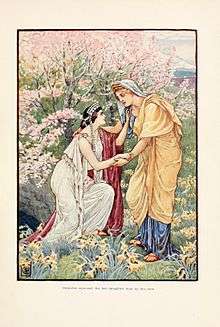
The myth of the capture of Persephone seems to be pre-Greek. In the Greek version, Ploutos (πλούτος, wealth) represents the wealth of the corn that was stored in underground silos or ceramic jars (pithoi). Similar subterranean pithoi were used in ancient times for funerary practices. At the beginning of the autumn, when the corn of the old crop is laid on the fields, she ascends and is reunited with her mother Demeter, for at this time the old crop and the new meet each other.[83]
According to the personal mythology of Robert Graves,[84] Persephone is not only the younger self of Demeter,[85] she is in turn also one of three guises of the Triple Goddess – Kore (the youngest, the maiden, signifying green young grain), Persephone (in the middle, the nymph, signifying the ripe grain waiting to be harvested), and Hecate (the eldest of the three, the crone, the harvested grain), which to a certain extent reduces the name and role of Demeter to that of group name. Before her abduction, she is called Kore; and once taken she becomes Persephone ('she who brings destruction').[86]
Demeter at Eleusis
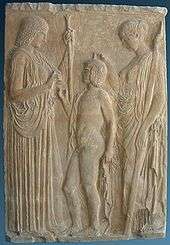
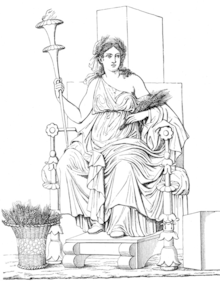
Demeter's search for her daughter Persephone took her to the palace of Celeus, the King of Eleusis in Attica. She assumed the form of an old woman, and asked him for shelter. He took her in, to nurse Demophon and Triptolemus, his sons by Metanira. To reward his kindness, she planned to make Demophon immortal; she secretly anointed the boy with ambrosia and laid him in the flames of the hearth, to gradually burn away his mortal self. But Metanira walked in, saw her son in the fire and screamed in fright. Demeter abandoned the attempt. Instead, she taught Triptolemus the secrets of agriculture, and he in turn taught them to any who wished to learn them. Thus, humanity learned how to plant, grow and harvest grain. The myth has several versions; some are linked to figures such as Eleusis, Rarus and Trochilus. The Demophon element may be based on an earlier folk tale.[87]
Demeter and Iasion
Homer's Odyssey (c. late 8th century BC) contains perhaps the earliest direct references to the myth of Demeter and her consort Iasion, a Samothracian hero whose name may refer to bindweed, a small white flower that frequently grows in wheat fields. In the Odyssey, Calypso describes how Demeter, "without disguise", made love to Iasion. "So it was when Demeter of the braided tresses followed her heart and lay in love with Iasion in the triple-furrowed field; Zeus was aware of it soon enough and hurled the bright thunderbolt and killed him."[88] In ancient Greek culture, part of the opening of each agricultural year involved the cutting of three furrows in the field to ensure its fertility.
Hesiod expanded on the basics of this myth. According to him, the liaison between Demeter and Iasion took place at the wedding of Cadmus and Harmonia in Crete. Demeter, in this version, had lured Iasion away from the other revelers. Hesiod says that Demeter subsequently gave birth to two sons, Philomelus and Ploutos.[73]
Demeter and Poseidon
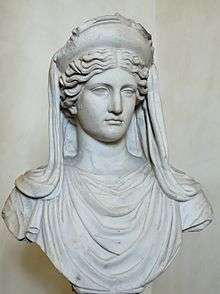
In Arcadia, located in what is now southern Greece, the major goddess Despoina was considered the daughter of Demeter and Poseidon Hippios, Horse-Poseidon. In the associated myths, Poseidon represents the river spirit of the underworld, and he appears as a horse as often happens in northern European folklore. The myth describes how he pursued his older sister, Demeter, who hid from him among the horses of King Onkios, but even in the form of a mare, she could not conceal her divinity. In the form of a stallion, Poseidon caught and raped his older sister. Demeter was furious at Poseidon's assault; in this furious form, she became known as Demeter Erinys. Her anger at Poseidon drove her to dress all in black and retreat into a cave in order to purify herself, an act which was the cause of a universal famine. Demeter's absence caused the death of crops, of livestock, and eventually of the people who depended on them (later Arcadian tradition held that it was both her rage at Poseidon and her loss of her daughter that caused the famine, merging the two myths).[26] Demeter washed away her anger in the River Ladon, becoming Demeter Lousia, the "bathed Demeter".[89]
"In her alliance with Poseidon," Karl Kerenyi noted,[90] "she was Earth, who bears plants and beasts, and could therefore assume the shape of an ear of grain or a mare." She bore a daughter Despoina (Δέσποινα: the "Mistress"), whose name should not be uttered outside the Arcadian Mysteries,[91] and a horse named Arion, with a black mane and tail.
At Phigaleia, a xoanon (wood-carved statue) of Demeter was erected in a cave which, tradition held, was the cave into which Black Demeter retreated. The statue depicted a Medusa-like figure with a horse's head and snake-like hair, holding a dove and a dolphin, which probably represented her power over air and water:[92]
The second mountain, Mt. Elaios, is about 30 stades from Phigaleia, and has a cave sacred to Demeter Melaine ["Black"]... the Phigalians say, they accounted the cave sacred to Demeter, and set up a wooden image in it. The image was made in the following fashion: it was seated on a rock, and was like a woman in all respects save the head. She had the head and hair of a horse, and serpents and other beasts grew out of her head. Her chiton reached right to her feet, and she held a dolphin in one hand, a dove in the other. Why they made the xoanon like this should be clear to any intelligent man who is versed in tradition. They say they named her Black because the goddess wore black clothing. However, they cannot remember who made this xoanon or how it caught fire; but when it was destroyed the Phigalians gave no new image to the goddess and largely neglected her festivals and sacrifices, until finally barrenness fell upon the land.
— Pausanias, Description of Greece 8.42.1ff.
Demeter and Erysichthon
Another myth involving Demeter's rage resulting in famine is that of Erysichthon, king of Thessaly.[26] The myth tells of Erysichthon ordering all of the trees in one of Demeter's sacred groves to be cut down. One tree, a huge oak, was found to be covered with votive wreaths, symbols of the prayers Demeter had granted, and so Erysichthon's men refused to cut it down. The king used an axe to cut it down himself, killing a dryad nymph in the process. The nymph's dying words were a curse on Erysichthon. Demeter punished the king by calling upon Limos, the spirit of unrelenting and insatiable hunger, to enter his stomach. The more the king ate, the hungrier he became. Erysichthon sold all his possessions to buy food, but was still hungry. Finally, he sold his own daughter, Mestra, into slavery. Mestra was freed from slavery by her former lover, Poseidon, who gave her the gift of shape-shifting into any creature at will to escape her bonds. Erysichthon used her shape-shifting ability to sell her numerous times to make more money to feed himself, but no amount of food was enough. Eventually, Erysichthon ate himself.[93][94]
See also
- Eleusinian Mysteries
- 1 Ceres, the first asteroid and dwarf planet discovered, named after Demeter's Roman equivalent and called Demeter in Greek
- 1108 Demeter, a main belt asteroid 26 km in diameter, which was discovered in 1929 by Karl Wilhelm Reinmuth at Heidelberg.
- Despoina
- Greek mythology in popular culture
- Isis and Osiris
- Poppy goddess
- Potnia
- Hades
- Law of Demeter, a software design guideline named in honor of Demeter.
- Ningishzida, an earlier Mesopotamian deity connected with vegetation and the underworld
Notes
- compare with Albanian dhe[17]
References
- https://www.jstor.org/stable/24617979
- Σιτώ. Cf. σῖτος. Liddell, Henry George; Scott, Robert; A Greek–English Lexicon at the Perseus Project.
- Eustathius of Thessalonica, scholia on Homer, 265.
- Themis was an ancient Greek goddess, embodiment of divine order, law. She was the organizer of the communal affairs and she evoked the social order: Finley, The World of Odysseus, rev. ed. Viking Press. (1978:78 note 82)
- John Chadwick, The Mycenean World. Cambridge University Press, 1976.
- Y. Duhoux, "LA > B da-ma-te = Déméter? Sur la langue du linéaire A," Minos 29/30 (1994–1995): 289–294.
- Y. Duhoux and A. Morpurgo-Davies, Companion to Linear B, vol. 2 (2011), p. 26. But see Ventris/Chadwick,Documents in Mycenean Greek p.242: B.Dietriech (2004):The origins of the Greek religion Bristol Phoenix Press. p.172
- "da-ma-te". Deaditerranean. Minoan Linear A & Mycenaean Linear B. "PY 609 En (1)". DĀMOS: Database of Mycenaean at Oslo. University of Oslo.
- Inscription MY Oi 701. "si-to-po-ti-ni-ja". Deaditerranean. Minoan Linear A & Mycenaean Linear B. "The Linear B word si-to". Palaeolexicon. Word study tool of Ancient languages. "MY 701 Oi (63)". DĀMOS: Database of Mycenaean at Oslo. University of Oslo. Cf. σῖτος, Σιτώ.
- "mother | Origin and meaning of mother by Online Etymology Dictionary". www.etymonline.com.
- Δᾶ in Liddell and Scott.
- "demeter | Origin and meaning of the name demeter by Online Etymology Dictionary". www.etymonline.com.
- Δημήτηρ. Liddell, Henry George; Scott, Robert; An Intermediate Greek–English Lexicon at the Perseus Project.
- R. S. P. Beekes. Etymological Dictionary of Greek, Brill, 2009, p. 324.
- Adams, John Paul, Mycenean divinities – List of handouts for California State University Classics 315. Retrieved 7 March 2011.
- Chadwick, The Mycenaean World, Cambridge University Press, 1976, p. 87) "Every Greek was aware of the maternal functions of Demeter; if her name bore the slightest resemblance to the Greek word for 'mother', it would inevitably have been deformed to emphasize that resemblance. [...] How did it escape transformation into *Gāmātēr, a name transparent to any Greek speaker?" Compare the Latin transformation Iuppiter and Diespiter vis-a-vis *Deus pater.
- Orel, Vladimir (1998). Albanian etymological dictionary. Brill. p. 80. ISBN 9004110240.
- West, Martin L. (24 May 2007). Indo-European Poetry and Myth. OUP Oxford. p. 176. ISBN 9780199280759.
The ∆α-, however, cannot be explained from Greek. But there is a Messapic Damatura or Damatira, and she need not be dismissed as a borrowing from Greek; she matches the Illyrian Deipaturos both in the agglutination and in the transfer to the thematic declension (-os, -a). (It is noteworthy that sporadic examples of a thematically declined ∆ημήτρα are found in inscriptions.) Damater/ Demeter could therefore be a borrowing from Illyrian. An Illyrian Dā- may possibly be derived from *Dʰǵʰ(e)m-
- Orphic Hymn 40 to Demeter (translated by Thomas Taylor: "O universal mother Deo famed, august, the source of wealth and various names".
- Compare sanskr. yava, lit. yavai, Δά is probably derived from δέFα :Martin Nilsson, Geschichte der Griechischen Religion, vol. I (Verlag C.H.Beck) pp 461–462.
- Harrison, Jane Ellen (5 September 1908). "Prolegomena to the study of Greek religion". Cambridge [Eng.] : The University press – via Internet Archive.
- Harrison, Jane Ellen. Myths of Greece and Rome. 1928. pp. 63-64
- Dietrich, p.181
- Nilsson, 1967:444
- Frisk, Griechisches Etymological Woerterbuch. Entry 1271
- Simon Hornblower, Antony Spawforth, Esther Eidinow, eds. The Oxford Companion to Classical Civilization. OUP Oxford, 2014.
- Isocrates, Panegyricus 4.28: "When Demeter came to our land, in her wandering after the rape of Kore, and, being moved to kindness towards our ancestors by services which may not be told save to her initiates, gave these two gifts, the greatest in the world – the fruits of the earth, which have enabled us to rise above the life of the beasts, and the holy rite, which inspires in those who partake of it sweeter hopes regarding both the end of life and all eternity".
- Hesiod Works and Days, 465
- Graves, Robert (1960). Greek Gods and Heroes. Dell Laurel-Leaf.
- Martin Nilsson, (1967), Die Geschichte der Griechische Religion, C.F.Beck Verlag Munchen, pp 462, 466, 675–676.
- Anesidora: inscribed against her figure on a white-ground kylix in the British Museum, B.M. 1881,0528.1, from Nola, painted by the Tarquinia painter, ca 470–460 BC (British Museum on-line catalogue entry)
- Hesychius of Alexandria s.v.
- Scholiast, On Theocritus ii. 12.
- Pausanias I 31,4- III 14,5
- Harrison, Jane Ellen. Myths of Greece and Rome. 1928. pp. 65-66
- Pausanias 8.13.13
- Martin Nilsson (1967).Die Geschichte der Griechiesche Religion Vol. I pp 477–478.
- Karl Kerenyi. Dionysos. Archetypal image of Indestructible life. part I iii. The Cretan core of Dionysos myth. Princeton University Press. 1976 p. 25
- Robert Graves. The Greek myths. 24.15, p 96 ISBN 0-14-001026-2
- A Linear A inscription can tentatively be read as DA-MA-TE (KY Za 2), which is possibly the name of the Mother Goddess.
- R.Wunderlich (1975),The secret of Creta.Souvenir Press Ltd.London p 319
- L. H. Jeffery (1976). Archaic Greece: The Greek city states c. 800-500 B.C. (Ernest Benn Limited) p. 42 ISBN 0-510-03271-0
- Pausanias 8.25.50
- C.M. Bowra (1957), The Greek Experience(1957:87, 169).
- Pausanias 1.22.3.
- Pausanias.Guide to Greece.9.39.2–5
- Herodotus, v. 61; Plutarch Isis et Osiris p. 378, d
- Smith, William (1867). "Achaea (1)". In Rachel, William (ed.). Dictionary of Greek and Roman Biography and Mythology. 1. Boston. p. 8.
- "Wa-na-ssoi, wa-na-ka-te, (to the two queens and the king). Wanax is best suited to Poseidon, the special divinity of Pylos. The identity of the two divinities addressed as wanassoi, is uncertain ": George Mylonas (1966) Mycenae and the Mycenean age" p.159 :Princeton University Press
- George Mylonas (1966), "Mycenae and the Mycenean world ". p.159. Princeton University Press
- Dietrich pp. 181–185
- Dietrich pp. 141
- Dietrich:166–167
- Cohen, A, Art in the Era of Alexander the Great: Paradigms of Manhood and Their Cultural Traditions, Cambridge University Press, 2010, p. 213. Googlebook preview
- L. H. Jeffery (1976) Archaic Greece: The City States c. 700–500 BC. Ernest Benn Ltd., London & Tonbridge pp. 72, 73, 78 ISBN 0-510-03271-0
- The Parian marble. Entry No 5: "When Amphictyon son of Hellen became king of Thermopylae brought together those living round the temple and named them Amphictyones;
- Pausanias, 7. 27, 9.
- Benko, Stephen, The virgin goddess: studies in the pagan and Christian roots of mariology, BRILL, 2004, note 111 on pp. 63 – 4, and p. 175.
- Larousse Desk Reference Encyclopedia, The Book People, Haydock, 1995, p. 215.
- Spaeth, Barbette Stanley, The Roman goddess Ceres, University of Texas Press, 1996, pp. 4, 6–13, citing Arnobius, who mistakes this as the first Roman cult to Ceres. His belief may reflect its high profile and ubiquity during the later Imperial period, and possibly the fading of older, distinctively Aventine forms of her cult.
- Scheid, John, "Graeco Ritu: A Typically Roman Way of Honoring the Gods," Harvard Studies in Classical Philology, 97, Greece in Rome: Influence, Integration, Resistance, 1995, p.23.
- Spaeth, Barbette Stanley, The Roman goddess Ceres, University of Texas Press, 1996, pp. 13, 15, 60, 94–97.
- Eur.Hel.1301-45 and Melanippid.764PMG.
- Kore / Persephone. Encyclopedia of the Hellenic World: Asia Minor. http://asiaminor.ehw.gr/Forms/fLemmaBody.aspx?lemmaId=10541#noteendNote_11
- Apuleius (1998). The Golden Ass. Penguin classics.
- Hesiod, Theogony 912; Homeric Hymn to Demeter (2); Pausnias, Description of Greece 8.37.9
- Kerényi, Karl. 1976. Dionysus. Trans. Ralph Manheim, Princeton University Press. ISBN 0691029156, 9780691029153
- Orpheus, fr. 145, in O. Kern, ed., Orphicorum fragmenta.
- Zuntz, G., Persephone. Three essays in religion and thought in Magna Graecia (Oxford 1971), p. 75-83.
- Martin Nilsson (1967) Die Geschichte der Griechische Religion pp.463, 477
- Pausanias.Description of Greece 5.15.4, 5, 6
- Hesiod, Theogony 969–974.
- Odyssey 5.125; Theogony 969 ff.
- Diodorus Siculus, The Library of History Book III.
- Pausanias, Description of Greece
- Karl Kerenyi, The Gods of the Greeks, 1951, pp.232 – 41 and notes 784 – 98.
- As in Burkert, Greek Religion (Harvard, 1985) p. 160.
- As in Porphyry
- "HOMERIC HYMN TO DEMETER". www.uh.edu.
- Ovid, Metamorphoses (Book V, ln. 533-571)
- Graf, "Demeter" in Brill's New Pauly
- "The Eleusinian Mysteries: The Rites of Demeter". Ancient History Encyclopedia. Retrieved 27 April 2019.
- Martin Nilsson, Greek Popular Religion. pp 48–50
- Graves' work on Greek myth was often criticized; see The White Goddess#Criticism and The Greek Myths.
- The idea that Kore (the maiden) is not Demeter's daughter, but Demeter's own younger self, was discussed much earlier than Graves, in Lewis Richard Farnell (1896), The Cults of the Greek States, volume 3, p.121.
- Graves, Robert. The Greek Myths. Penguin, 1990. ISBN 0-14-001026-2. 24. pp.94–95.
- Nilsson (1940), p. 50: "The Demophon story in Eleusis is based on an older folk-tale motif which has nothing to do with the Eleusinian Cult. It is introduced in order to let Demeter reveal herself in her divine shape".
- Homer, Odyssey 5. 125 ff (trans. Shewring)
- Other ritually bathed goddesses were Argive Hera and Cybele; Aphrodite renewed her own powers bathing herself in the sea.
- Kerenyi, The Gods of the Greeks, 1951:185.
- "In Arcadia she was also a second goddess in the Mysteries of her daughter, the unnameable, who was invoked only as 'Despoina', the 'Mistress'" (Karl Kerenyi, Eleusis: Archetypal Image of Mother and Daughter(Princeton University Press) 1967:31f, instancing Pausanias, viii.37.9.
- L. H. Jeffery (1976). Archaic Greece: The Greek city states c. 800-500 B.C. (Ernest Benn Limited) p 23 ISBN 0-510-03271-0
- Ovid. Metamorphoses VIII, 738-878
- Callimachus, Hymn to Demeter, 34 ff
- Walter Burkert (1985) Greek Religion, Harvard University Press, 1985.
- Ingri and Edgar Parin d'Aulaire, D'Aulaire's Book of Greek Myths, 1962. An illustrated book of Greek myths retold for children.
- Gantz, Timothy, Early Greek Myth: A Guide to Literary and Artistic Sources, Johns Hopkins University Press, 1996, Two volumes: ISBN 978-0-8018-5360-9 (Vol. 1), ISBN 978-0-8018-5362-3 (Vol. 2).
- Jane Ellen Harrison, Prolegomena to the Study of Greek Religion, 1903
- Hesiod, Theogony, in The Homeric Hymns and Homerica with an English Translation by Hugh G. Evelyn-White, Cambridge, MA., Harvard University Press; London, William Heinemann Ltd. 1914. Online version at the Perseus Digital Library.
- Homer, The Iliad with an English Translation by A.T. Murray, PhD in two volumes. Cambridge, MA., Harvard University Press; London, William Heinemann, Ltd. 1924. Online version at the Perseus Digital Library.
- Homer; The Odyssey with an English Translation by A.T. Murray, PH.D. in two volumes. Cambridge, MA., Harvard University Press; London, William Heinemann, Ltd. 1919. Online version at the Perseus Digital Library.
- Karl Kerenyi, Eleusis: archetypal image of mother and daughter, 1967.
- Karl Kerenyi, Dionysos: Archetypal Image of Indestructible Life, 1976
- Martin P. Nilsson, Greek Popular Religion, 1940. Sacred-texts.com
- Pausanias, Pausanias Description of Greece with an English Translation by W.H.S. Jones, Litt.D., and H.A. Ormerod, M.A., in 4 Volumes, Cambridge, MA, Harvard University Press; London, William Heinemann Ltd. 1918.
- Carl Ruck and Danny Staples, The World of Classical Myth, 1994.
- Graf, Fritz. "Demeter," Brill's New Pauly, Ed. Hubert Cancik and et al. Brill Reference Online. Web. 27 September 2017.
External links
| Wikimedia Commons has media related to Demeter. |
- Hymn to Demeter, Ancient Greek and English text, Interlinear Translation edited & adapted from the 1914 prose translation by Hugh G. Evelyn-White, with Greek-English glossary, notes and illustrations.
- Foley P. Helene, The Homeric hymn to Demeter: translation, commentary, and interpretive essays, Princeton Univers. Press, 1994. with Ancient Greek text and English translation.
- Text of Homeric Hymn to Demeter
- Online book of Martin P. Nilsson, Greek Popular Religion
- "The Political Cosmology of the Homeric Hymn to Demeter"
- "The Sophian Prayer to Demeter"

